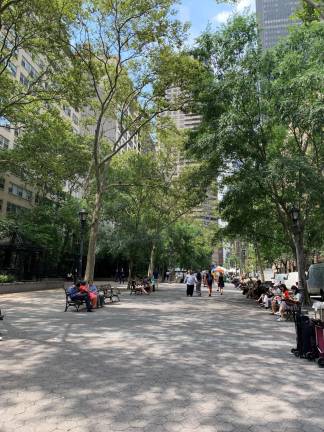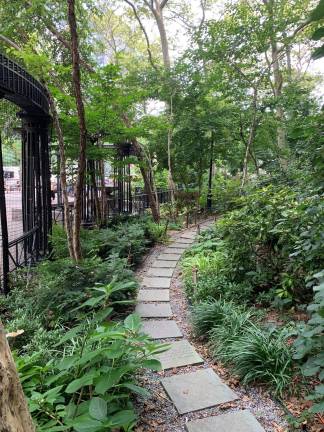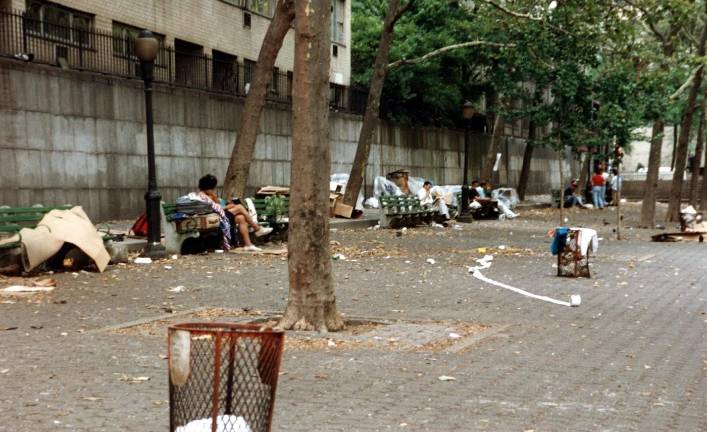Milestone for Dag Hammarskjold Plaza
The East Side community celebrates 20 years of a vibrant transformation
By Ema Schumer
Nestled between the Headquarters of the United Nations and the hustle and bustle of East Midtown rests Dag Hammarskjold Plaza. Spanning 1.5 acres along 47th Street between First and Second Avenues, the plaza is multipurpose: it is the site of political protests, a vegetarian café, a garden, art installations and a farmer’s market. It also welcomes a diverse array of patrons: on an ordinary day, Turtle Bay residents, UN officials and midtown office workers can be seen in the plaza, people-watching from a park bench, sipping coffee at the café or strolling through the garden.
“This is a place that is part of the fabric of New York City in general,” says Sherrill Kazan, who has spent most of her life in the area and is the president of a nonprofit that finances the plaza’s upkeep. “It’s a place where people can express themselves legally; it’s a place of sculpture and art and internationalism. This one street of Manhattan is a vision that is kept alive by people.”
These people to whom Kazan alludes include the local volunteers who comprise Friends of Dag Hammarskjold Plaza - a nonprofit that works to preserve the plaza. This year, with the help of Friends, the plaza celebrates 20 years of serving the community.
Dag Hammarskjold Plaza’s anniversary marks 20 years since the plaza reopened following a major renovation project, orchestrated by the city, that transformed the plaza into what it is today. The project included the creation of the Katharine Hepburn Garden and the addition of a half-acre to the plaza to provide a visual connection to the UN.
Brief History of the Plaza
The plaza, however, has not always been such a hub of community. The city acquired the land in 1948, after the area abutting the East River — formerly slaughterhouses — was transformed to make room for the UN’s headquarters. In 1961, the city dedicated the plaza to Dag Hammarskjold, the revered UN Secretary-General who had died in a plane crash earlier that year and was posthumously awarded the Nobel Peace Prize. For the latter half of the twentieth century, the plaza languished. It was the site of gravel, homeless people and lots of trash, Kazan said.
Under such conditions, one day in 1992, Anne Saxon-Hersh traversed the plaza. To her horror, the park was a “homeless encampment.”
“I thought to myself, ‘this is not acceptable. This is not a park,’” she said. Saxon-Hersh snapped a photo of the plaza and solicited signatures from local Democrats to urge the city to take action. In large part to the credit of the Turtle Bay Association, the city made improvements to the park. The local community board, CB6, has also been a strong advocate for the well-being of the plaza over the years.
The plaza soon deteriorated, however, Saxon-Hersh said. It was at that point she realized the need for a body to be formed that would constantly work to maintain the plaza. So in 1993, Saxon-Hersh helped found Friends of Dag Hammarskjold. Today she is the Director of Development.
Where “Good Defeats Evil”
At the West entrance to the plaza, the UN’s vast lawn along the East River is visible. Situated on the lawn is a sculpture of St. George slaying the dragon. The artwork, entitled “Good Defeats Evil,” was gifted to the UN at the end of the Cold War. The meaning behind and significance of the sculpture might be elusive to many, but not Kazan. With pride, she likes to refer to Dag Hammarskjold Plaza as a “Gateway to the United Nations.” “From one end to the plaza to the other you feel connected to the iconic structure of the UN,” she said.
Due to the plaza’s proximity to the UN, it is no surprise that Dag Hammarskjold Plaza has hosted numerous demonstrations. In 2017, when millions of people throughout the U.S. took part in the first Women’s March, the plaza was the point of departure for New York City’s procession. On the last day of July this summer, protestors gathered at the east end of the plaza calling on the UN to force French military troops to leave their home country of Mali. Balla Sissoko, who identified himself as the president of the Mali community in New York, said that the location makes it “a very powerful place” for protestors. “If we want to stand for something instead of falling for anything this spot ... is extremely forceful.”
The plaza is also the site of the Katharine Hepburn Garden, which Saxon-Hersh calls her “first love.” Named for the Academy Award-winning actress who was a resident of Turtle Bay, the garden includes an array of plants, a bench donated by Hepburn’s estate, and some of the legendary actress’s quotations carved into the stone ground. This past July, Saxon-Hersh organized the Hydrangea Fest Garden Celebration, which included garden tours for attendees to learn about the collection and how to create their own arrangements. “You walk through here for five minutes [and] it will help you mentally, emotionally, physically and spiritually,” said Kazan. “It changes the mood [of] all of the hustle of life.”
A Financial Challenge
Friends constantly struggles to raise the funds necessary to preserve the plaza. Though the Parks department will provide maintenance services (such as fixing one of the fountains) upon request and infrequent, large-scale restorations, Saxon-Hersh explained that maintenance on a day-to-day level is required to keep the plaza clean and safe. “You can’t have people who are sick at the plaza. You can’t have people with open wounds or people who don’t pick up after their dogs or [who] feed pigeons and attract rats,” she said. (Indeed, in 2011, DNAinfo reported allegations that women from a nearby shelter were having sex and using drugs on Hepburn’s former bench, which resulted in the police making several arrests.)
Though the plaza is frequented by members of the surrounding area—which includes office buildings, high rise condominiums and the UN–Kazan and Saxon-Hersh both expressed difficulty in getting people to contribute financial support to Friends to preserve the plaza. “We have to keep reminding people [that] the health of this plaza is the health of the properties around the area. People have no clue what this was like,” Kazan said. Through continual support of Friends, the two women hope that future generations will only see Dag Hammarskjold Plaza as a vibrant green space — a status it has enjoyed for the past 20 years and counting.


